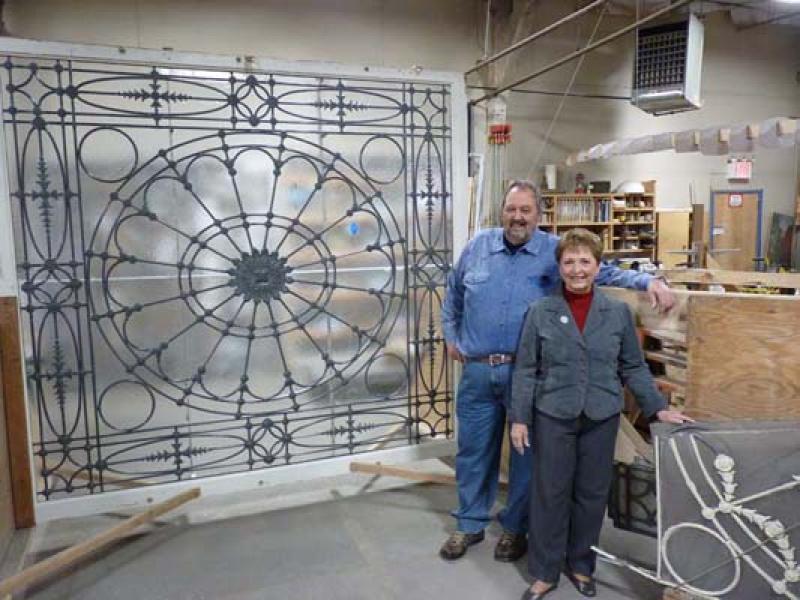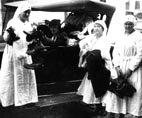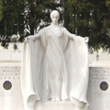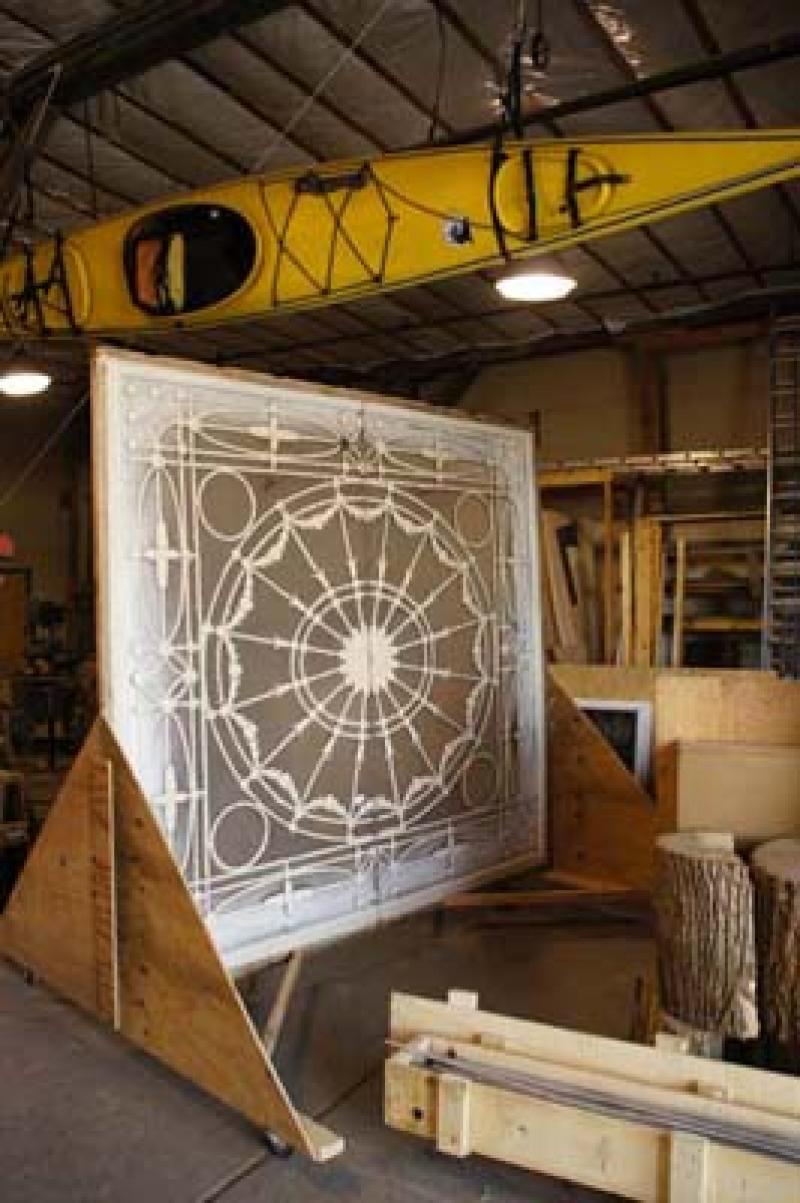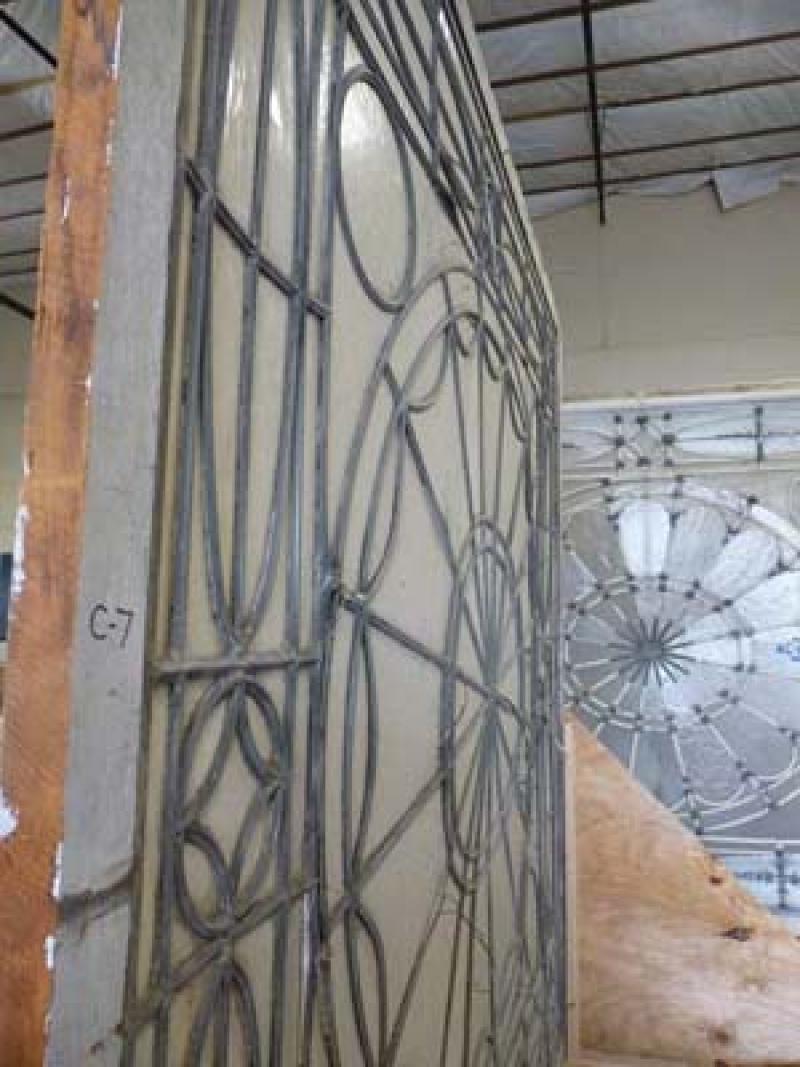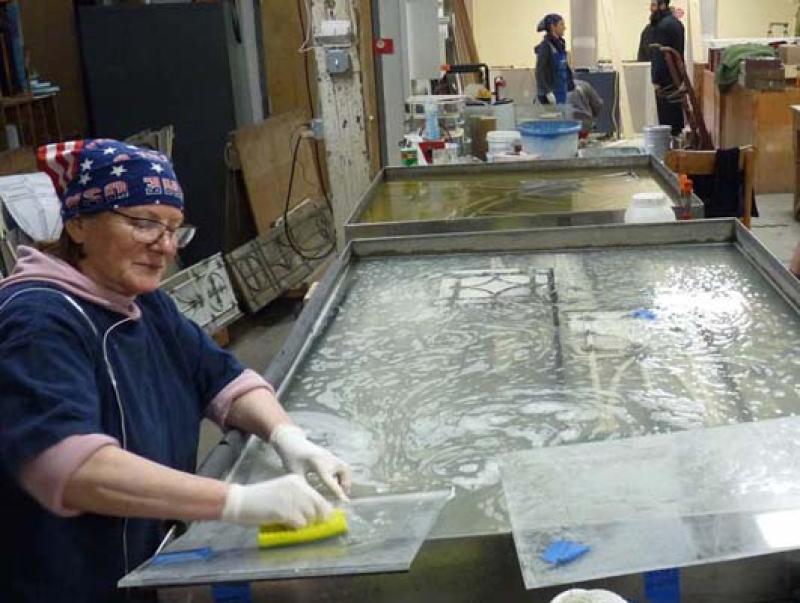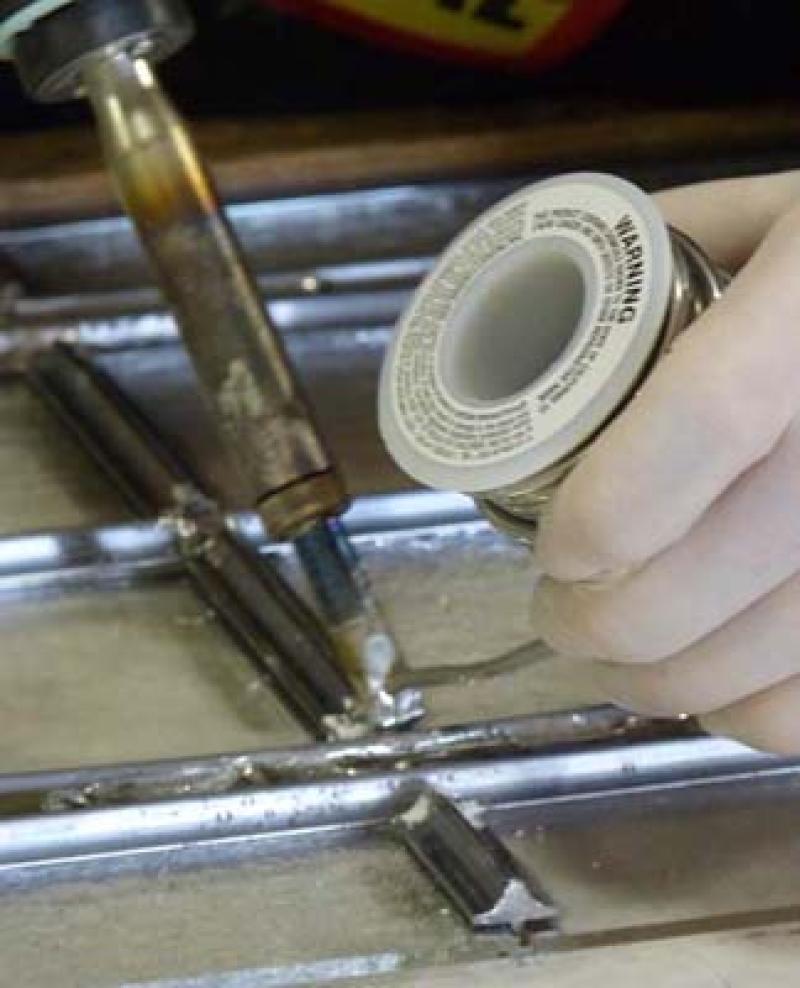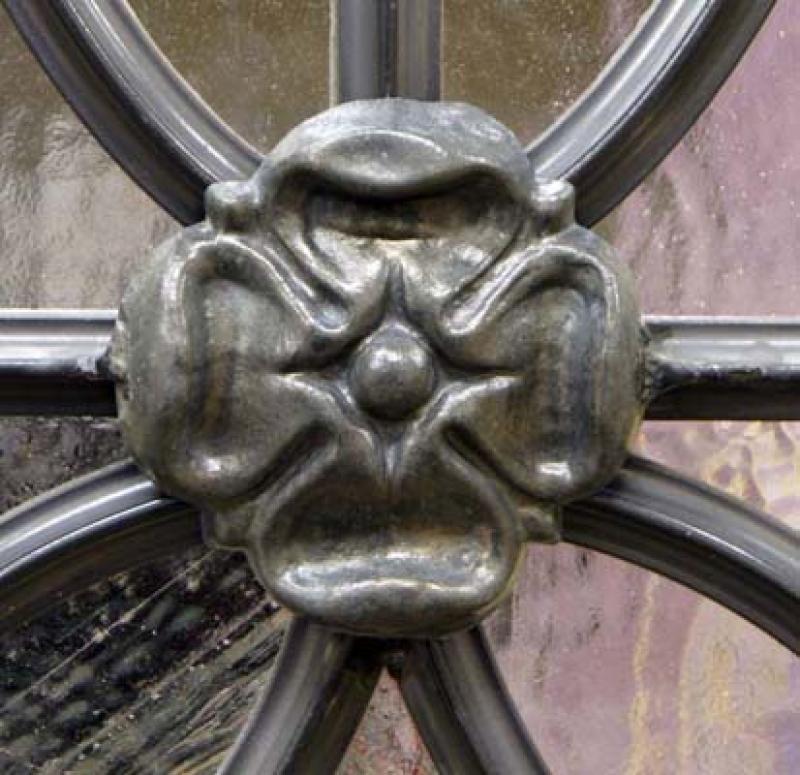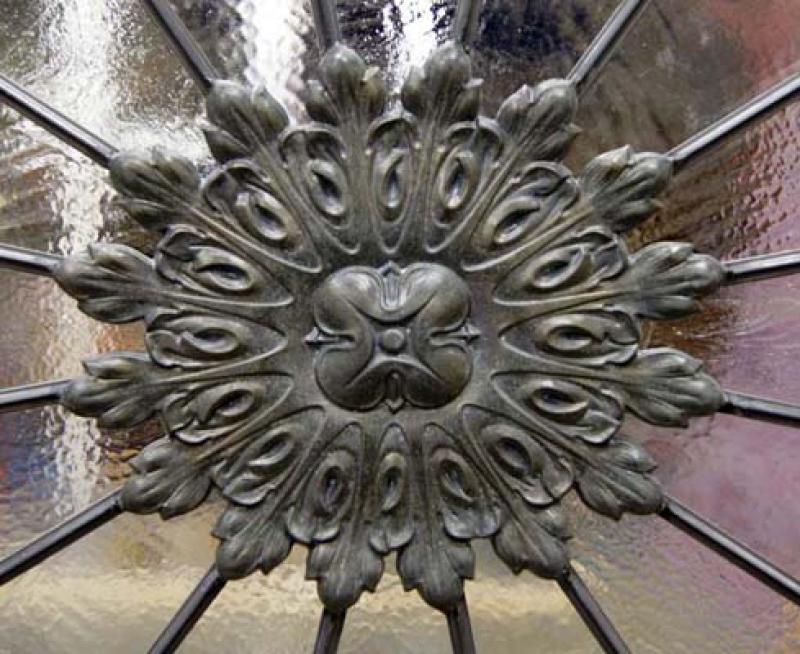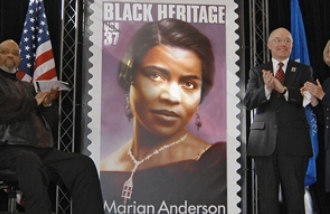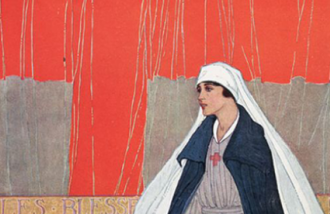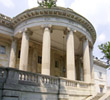Before and after: The 100–year–old DAR Library Lay Light is being transformed from dirty, deteriorating panels (left) to cleaned, restored and structurally strengthened panels (right). The panel in need of restoration at left, shows the paint overspray covering the edges of the glass. The painted ornamentation is chipping and the glass is covered in 100 years of dirt. The support system holding the 25 9 foot by 8 foot glass panels that make up the ceiling of the DAR Library was failing, as well. The panels, which are being restored by the historic glass preservation firm Femenella & Associates, will be dismantled, cleaned, and pieced back together using primarily the original materials, but with stronger lead cames and an enhanced support system. The following photos show the step–by–step process of how the panels are being historically restored.
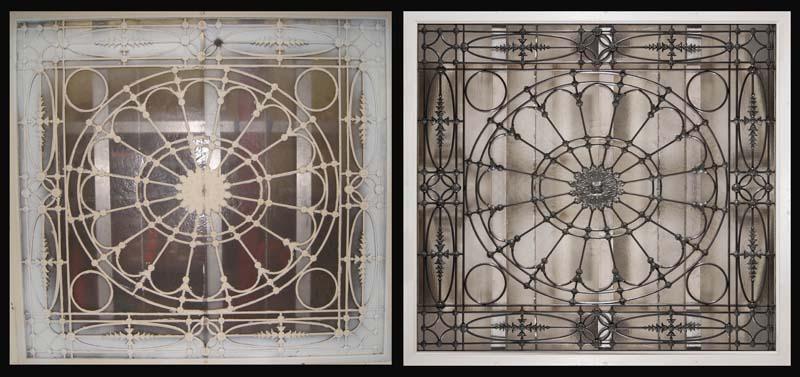
All 25 of the library lay light panels and the two Memorial Continental Hall stairwell lay light panels were transported to a restoration studio in Brooklyn, where specially trained craftsmen work to restore the panels.
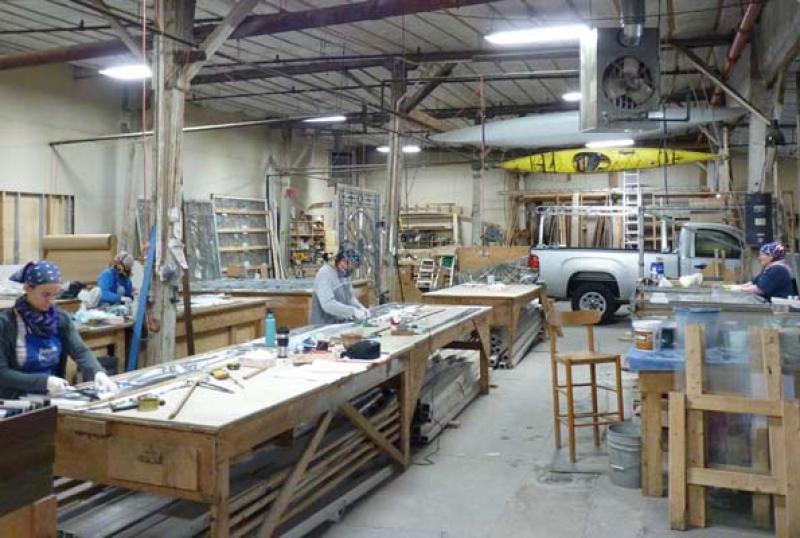
The aluminum frame that the riggers installed on the panel to lower it from the ceiling and stabilize it during transport (seen on the back of the panel in this photo) is removed. The support bars original to the panel are also removed.
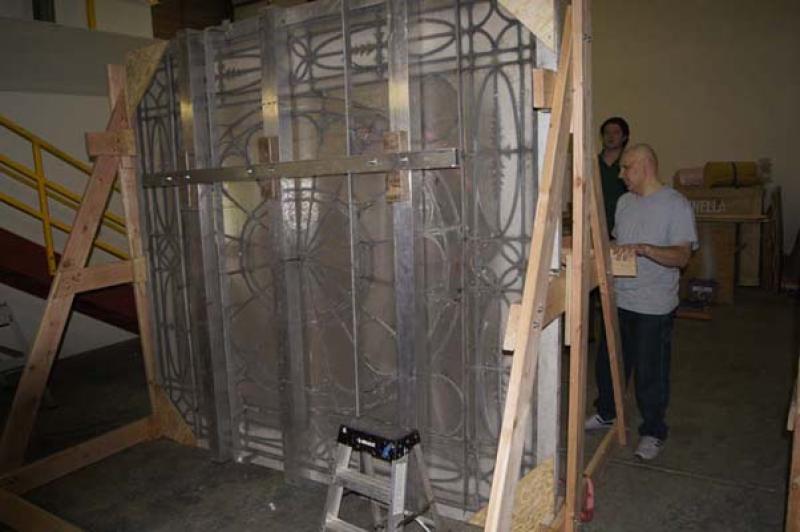
Christman Company, the contracting firm overseeing the lay light project, strategically labeled all of the panels in order to keep track of the location for each one, so as to reinstall in their exact original location in the DAR Library ceiling.
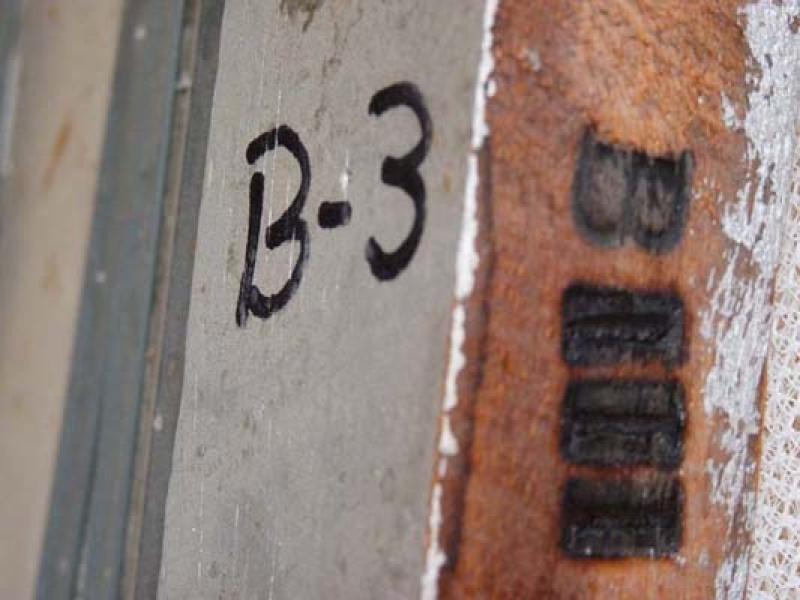
Femenella & Associates then used the identification system to document the locations of the specific pieces within the window. They photograph and carefully label each piece in its present condition and then create a chart to monitor which pieces of the panel are at what specific stage in the restoration process.
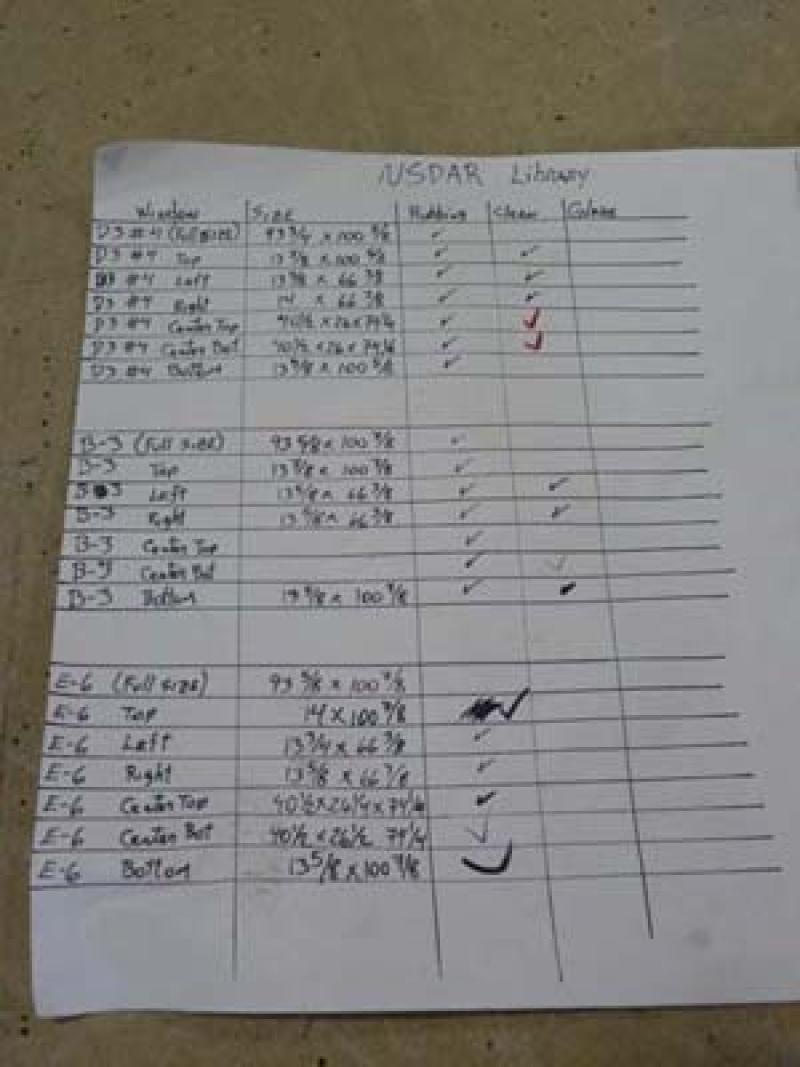
On the back of the panel a rubbing is done in order to get a map of its design. Placing tracing paper on the back of the panel and rubbing a wax block over the lead cames provides an impression of the cames that can be used as a template to put the pieces back together.
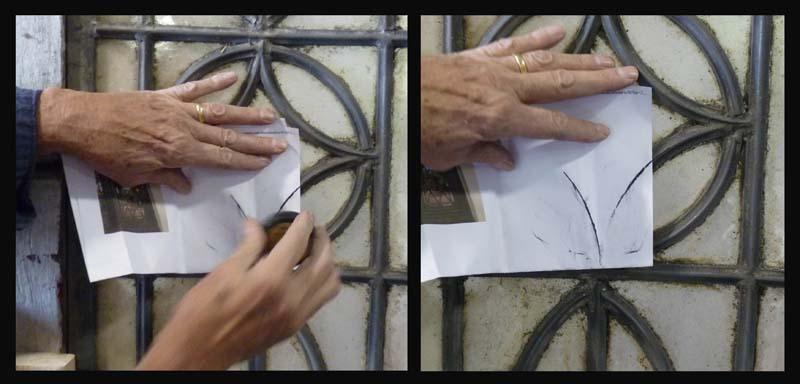
An example of one of the rubbings that is used to piece the glass and cames back together.
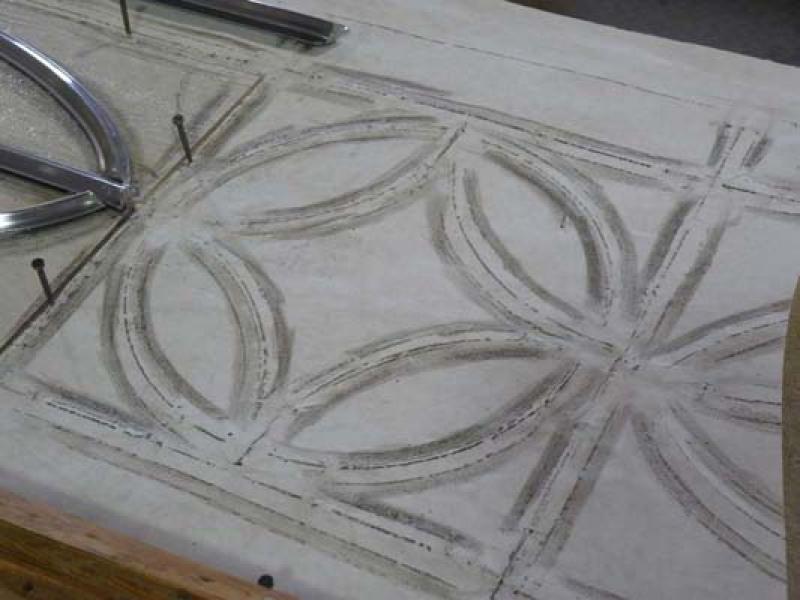
The decorative ornamentation is then carefully removed from the front of the panel.
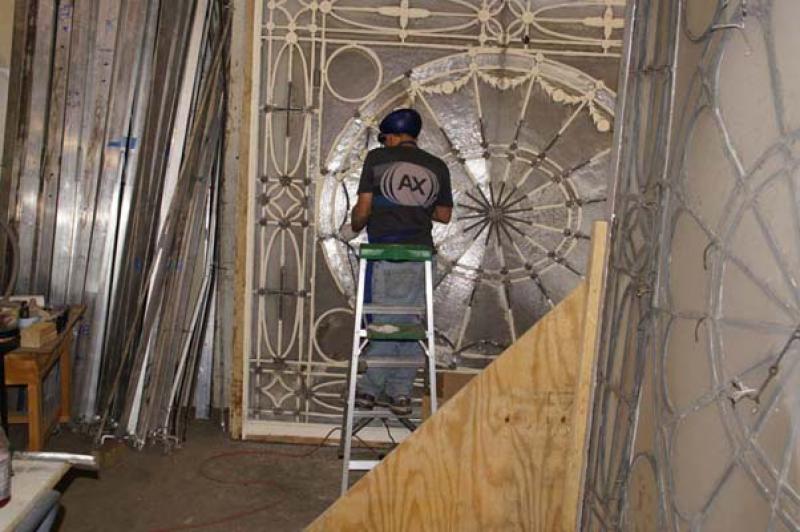
You can see on this panel that the grey, unpainted areas are where the ornamentation has been removed from the cames. It appears the ornamentation was originally soldered onto the cames and then subsequently painted white.
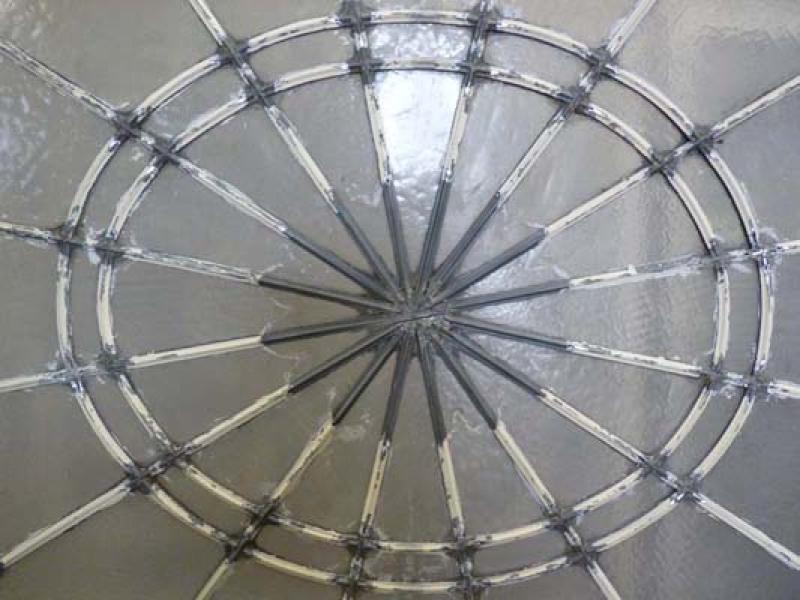
The removed ornaments are organized according to which panel they belong to so as to go back on the exact panel.
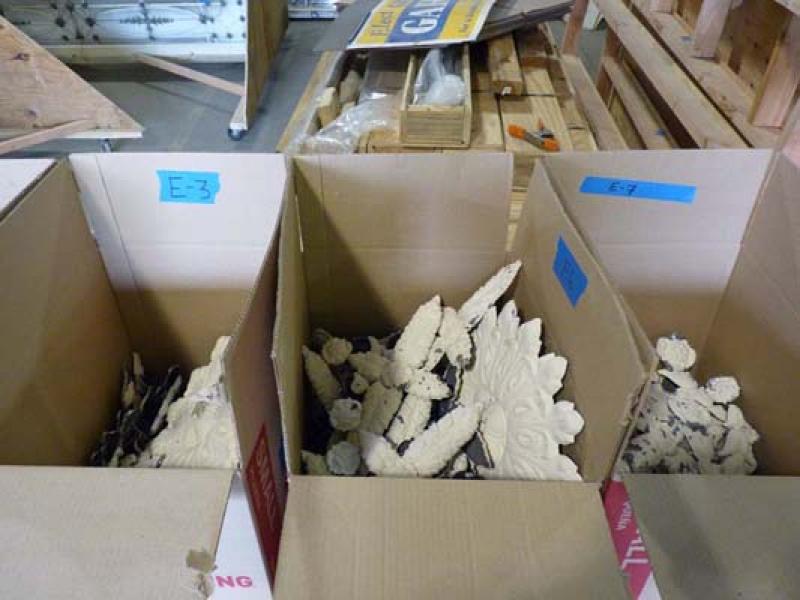
The paint is stripped from the ornamentation and the pieces are cleaned and buffed.
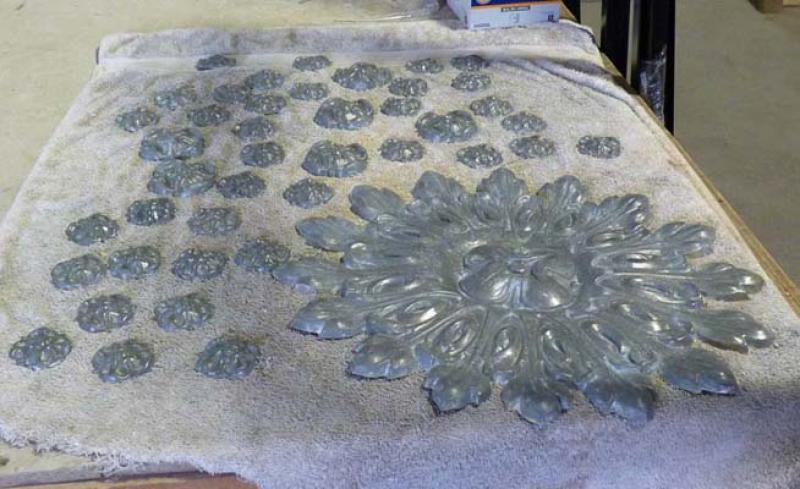
A dremel is used to cut through the soldered joints in preparation for dismantling the large window.
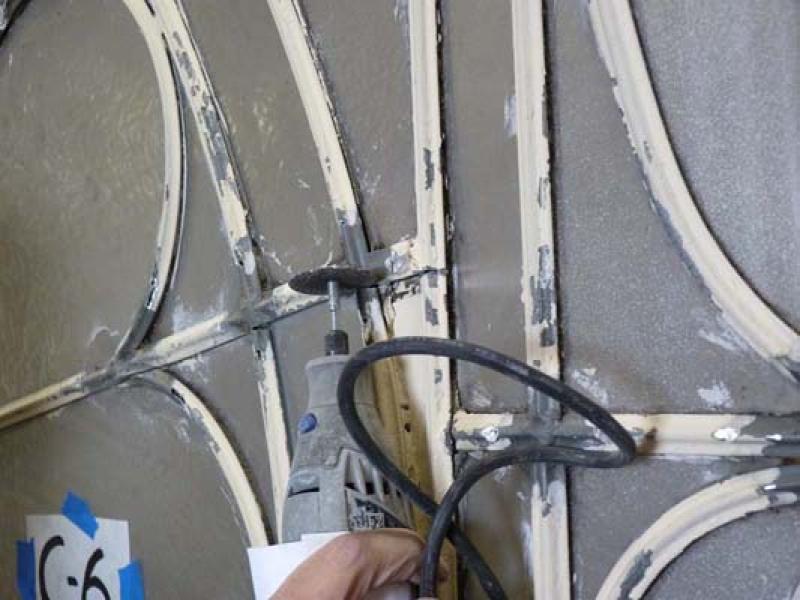
The dremel has cut through the intersection of soldered joints at the center of the panel.
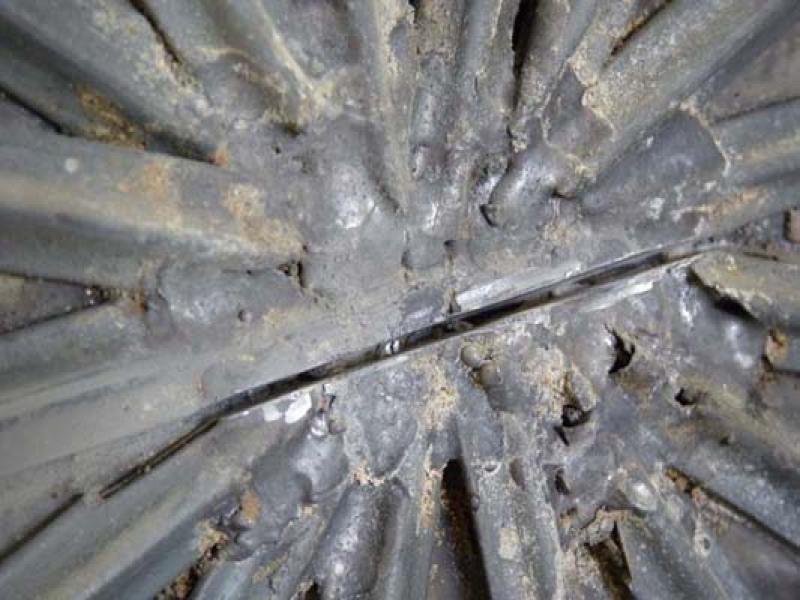
The individual lay light panels are the largest decorative glass units Art Femenella has worked on in his 38 years of experience. In order to make the window a reasonable size to work with, it has to be broken down into eight sections. This drawing shows how the panel is cut along its natural joints to create eight separate sections.
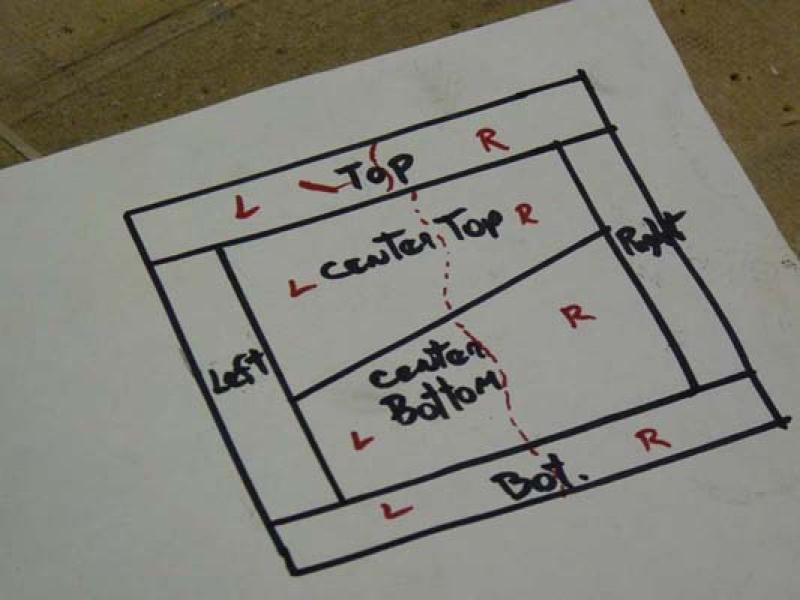
Workers must carefully cut through the soldered joints on both sides of the panel to get through the lead without cutting into the glass. Then the pieces are carefully removed from the wood frame section by section.
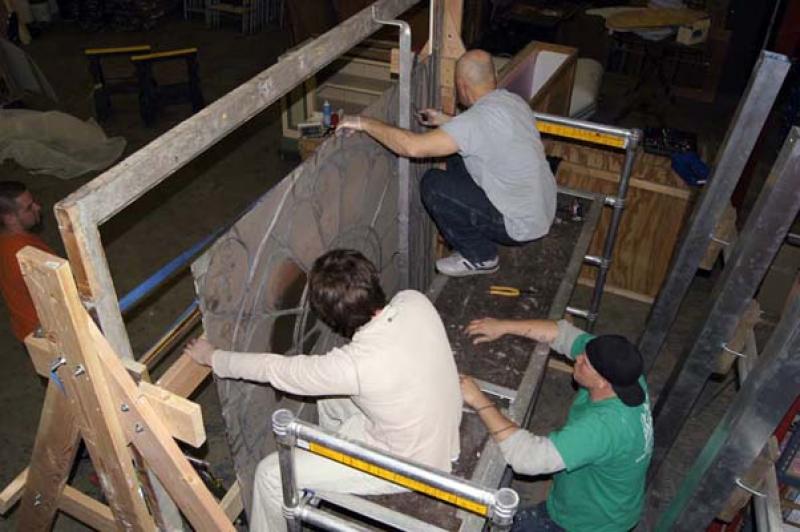
The eight sections will be further deconstructed to salvage the historic glass.
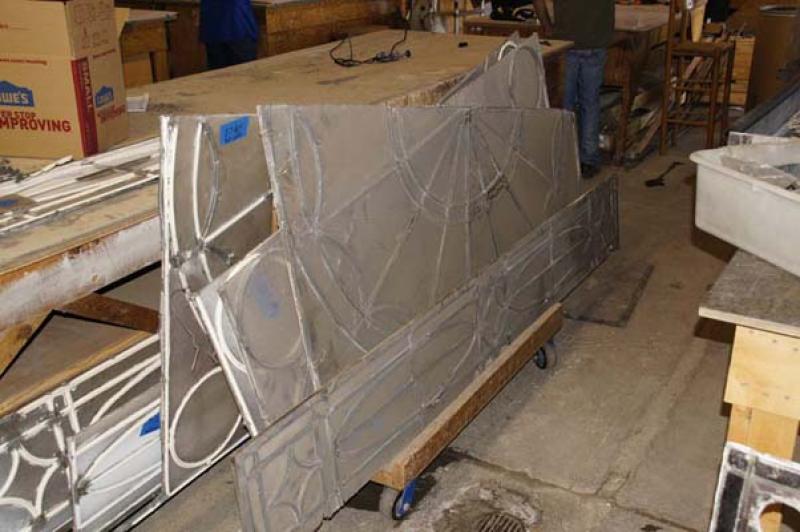
At this size, the panel sections can be worked on flat. Using the dremel, the lead is cut away to remove each individual piece of glass.
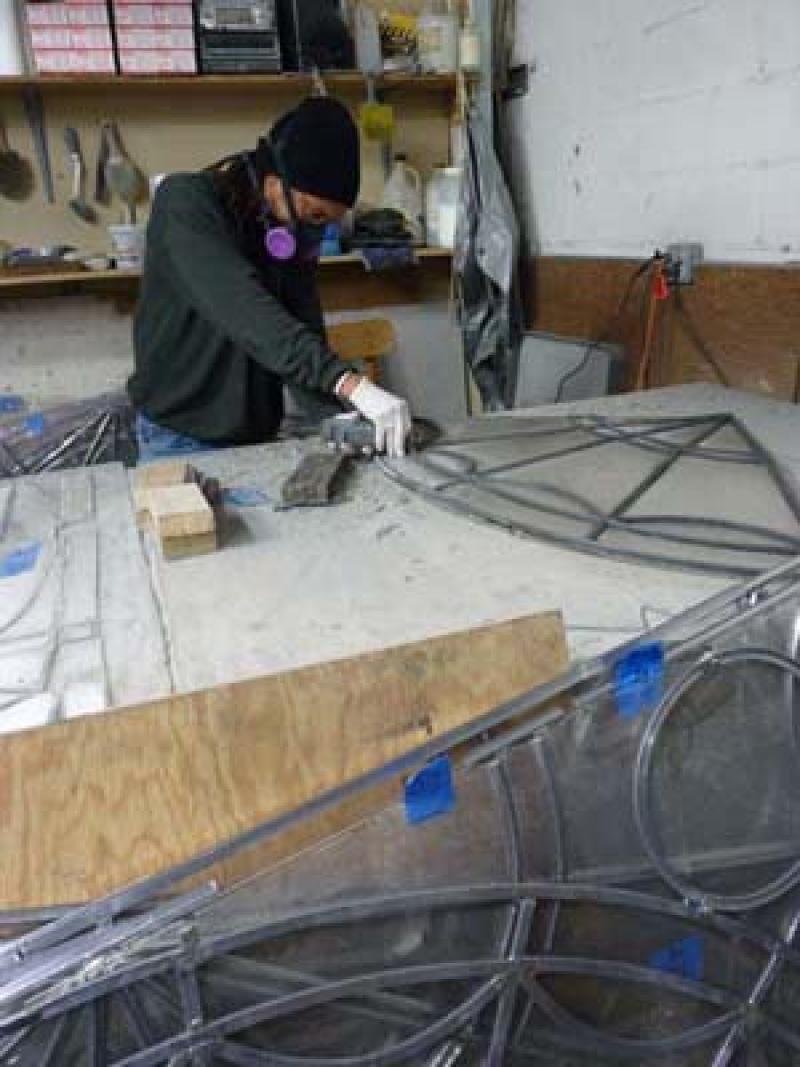
In this close up photo you can see how the lead is making the glass bow and warp as opposed to lying flat against the table as it should.
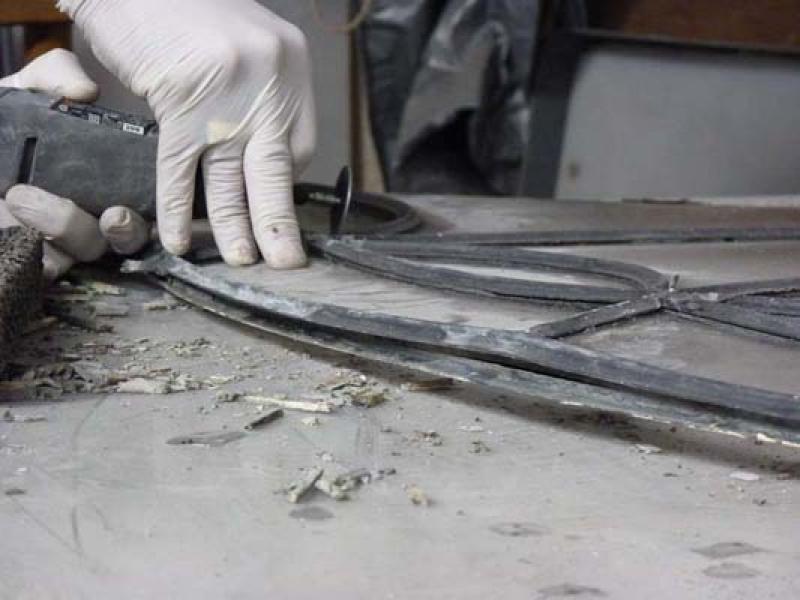
Pieces get smaller as the lead is being removed and discarded and glass is being preserved.
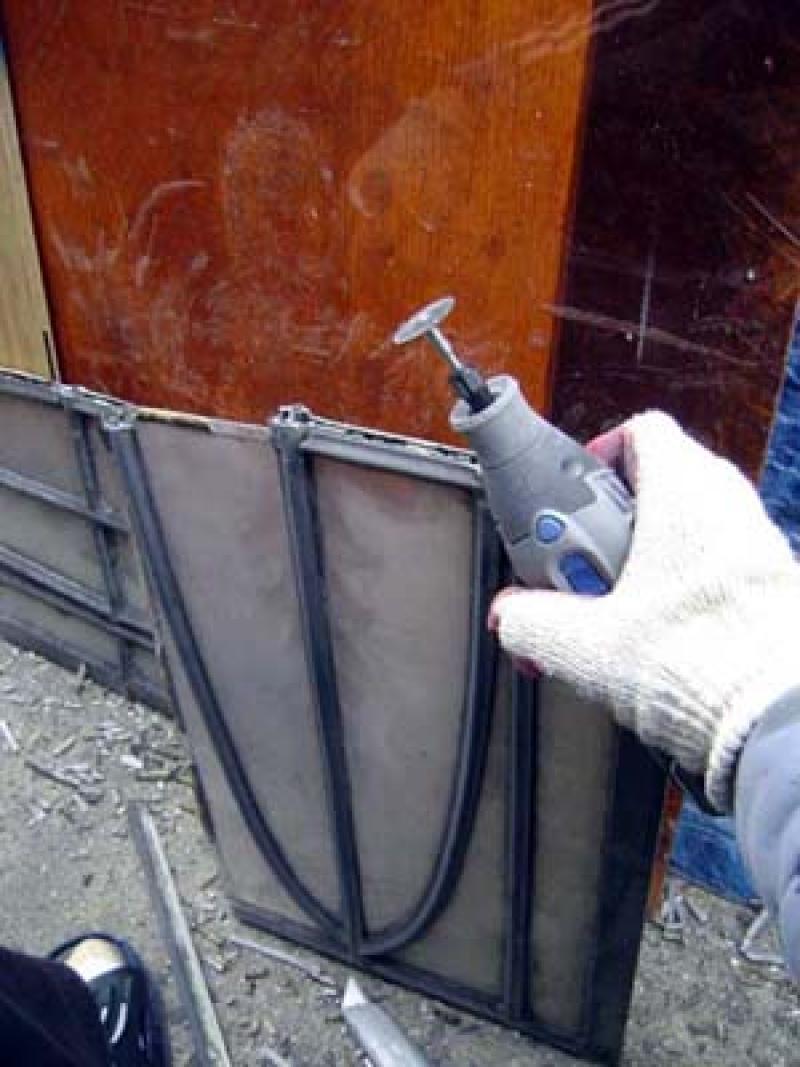
Discarded lead cames. The original lead cames were posing the most risk to the lay light because they had warped and deteriorated over time, allowing the glass to bow and become loose in the frame. The cames will be replaced in the restored panel with stronger lead cames, while the original glass will be reused in the panel.
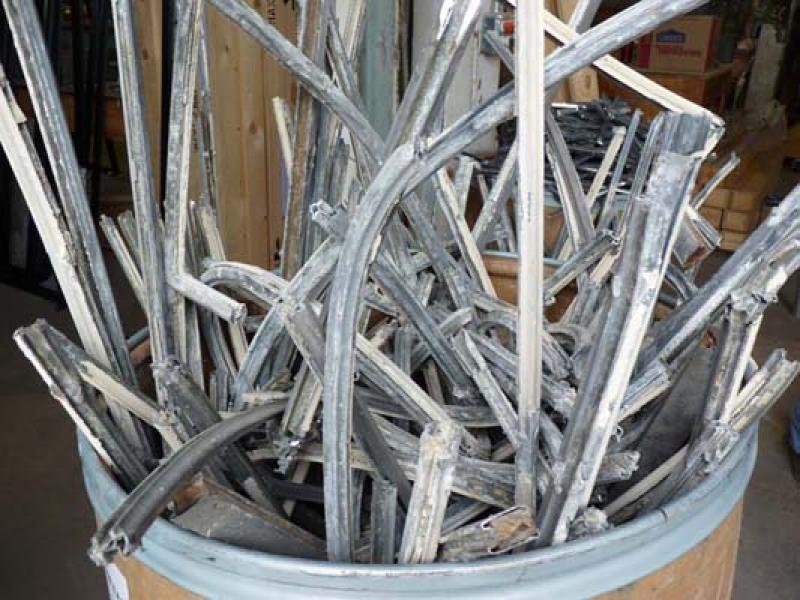
With the cames removed, you can see how much paint overspray covered some of the glass in the panel.
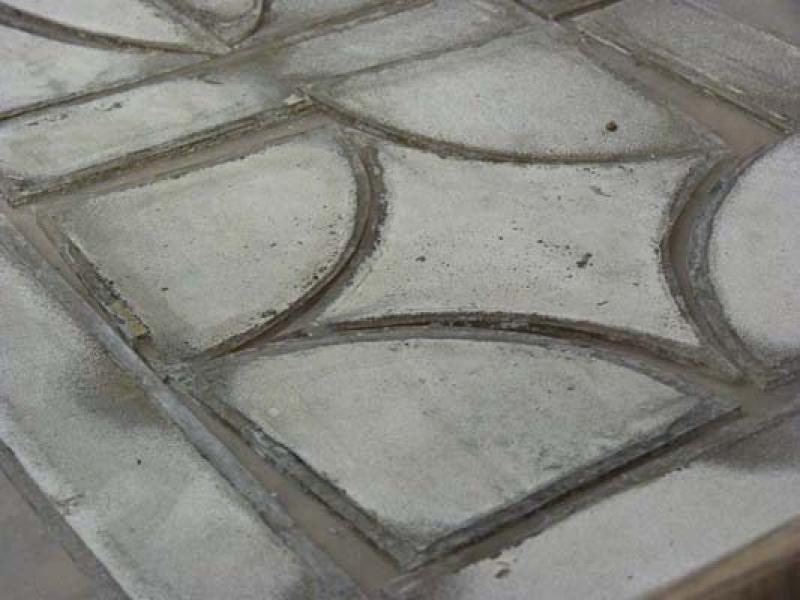
To clean the dirt and remove the paint overspray, the glass is soaked and cleaned using dishwashing soap.
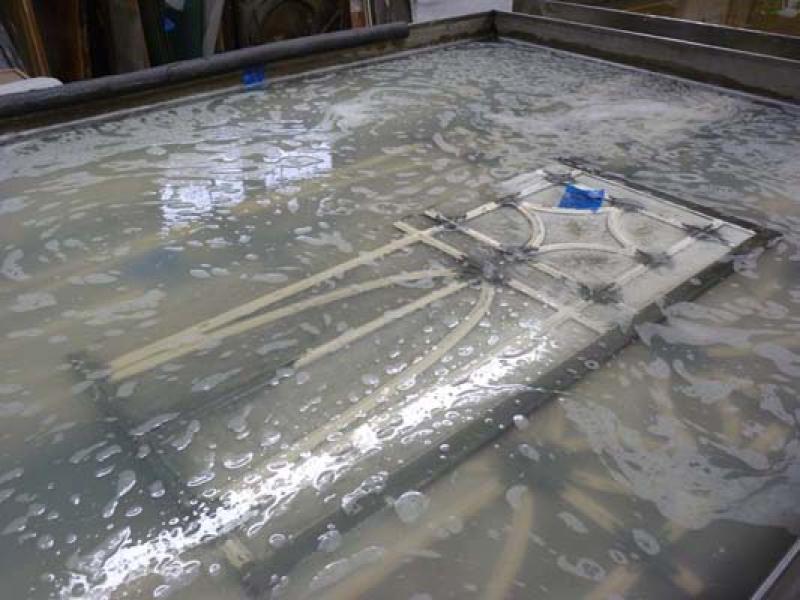
Once the glass is clean, it is placed on the rubbing to mirror its original design in the panel. Labeled drawers identify the separate sections of the panels.
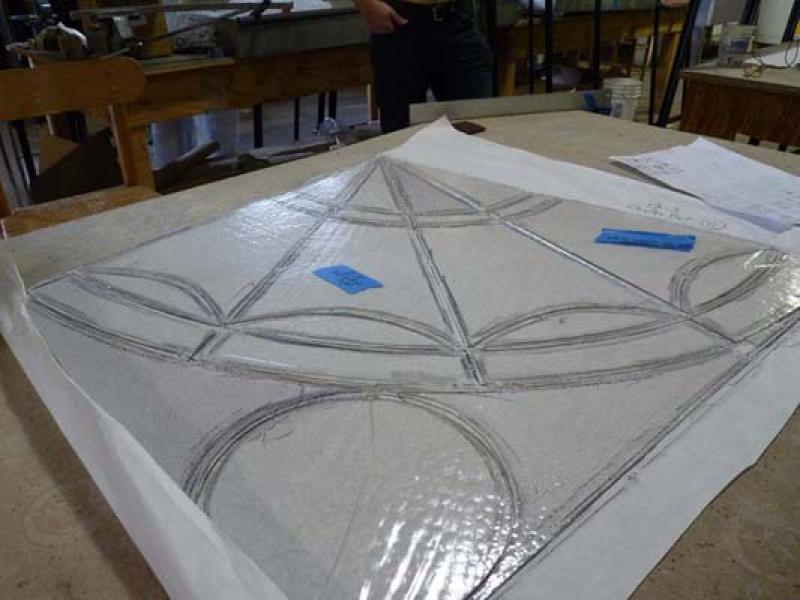
At this point in the process, a decision must be made if there is any broken glass in the section. Miraculously, the majority of the original glass has been preserved in the panels. Any broken glass will be replaced since all of the glass is very similar. Howevere, there is already variation in the various glass pieces, so it won't look strikingly different when replacements are used.
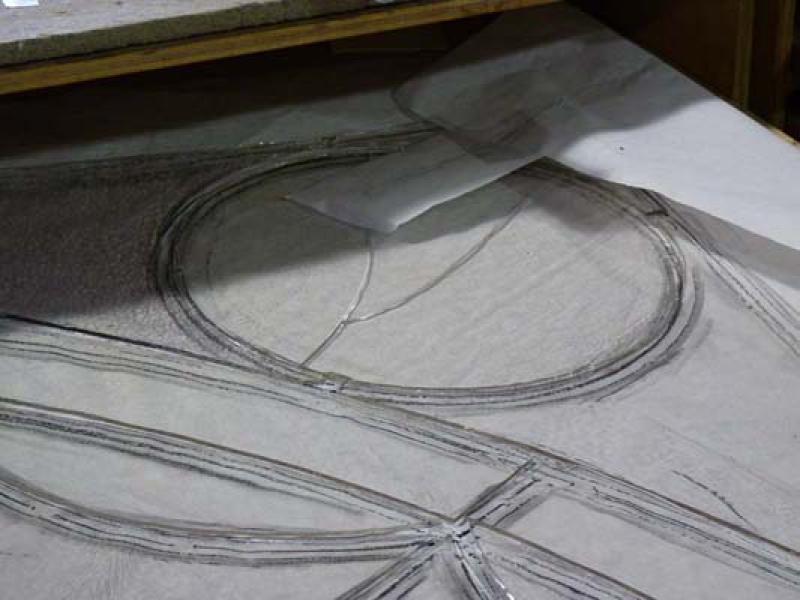
Approximately 5-6% of the glass shows evidence of "solarization." Solarization occurs when the original batch of sand used to create the glass had a high iron content that turned the glass a greenish color. To offset the green color, workers applied manganese. When the manganese is exposed to the sun it turns the glass a pinkish color. You can see the effect in this extreme example–which is not glass from any of the lay light panels–where the edges that were shielded from the sun remain clear, but the center of it has turned a dark pink color.
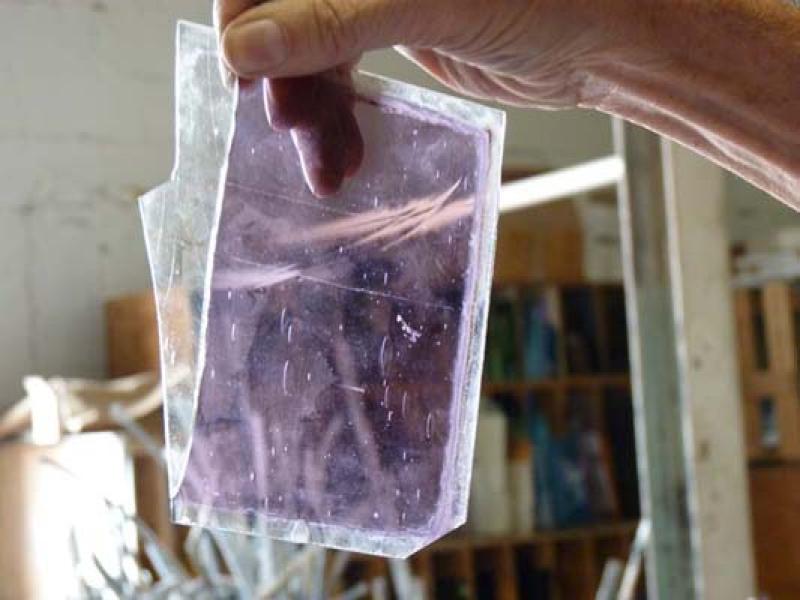
The solaraized pieces of glass in the DAR lay light–such as this example–show less extreme discoloration, just a subtle pink tint. All of these solarized original pieces of glass are being kept in the restored panels, but you likely won't be able to notice the difference when looking at the panels 40 feet above.
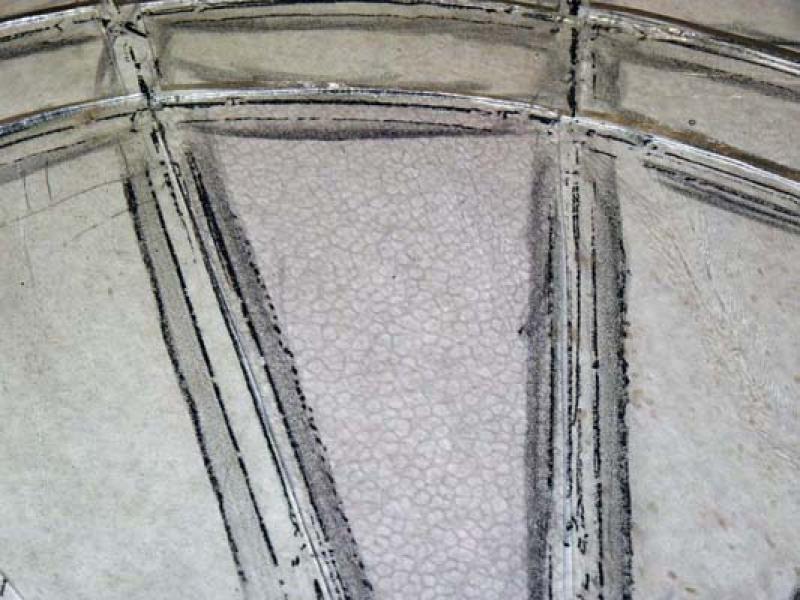
The next part of the restoration is the glazing process. Glazing is the term used to describe putting the glass pieces together with the lead. You start with a straight piece of lead and then bend the lead to fit the shape of the specific glass it is holding together. The lead is marked to the length needed and then cut to size.
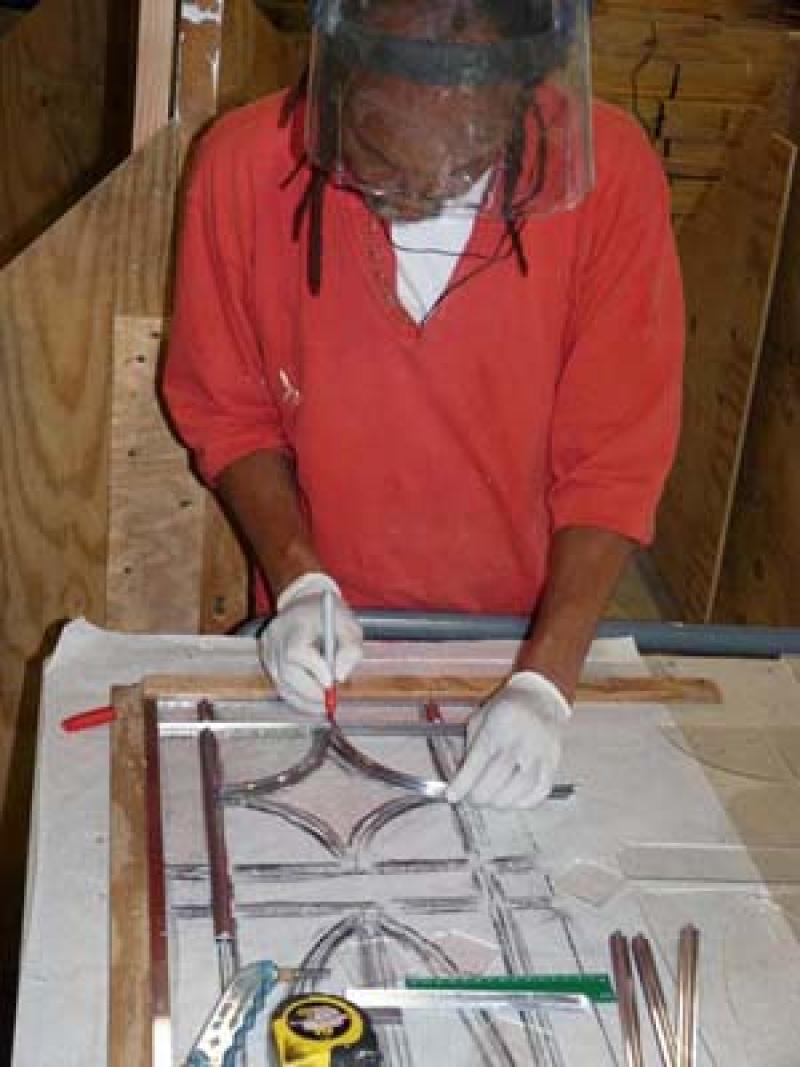
Here is a section in the middle of the glazing process. A stopping knife is used to push the lead around and dress the joints. Nails are used to hold the pieces in their exact place in preparation for the next piece of lead or glass to be fit to the section.
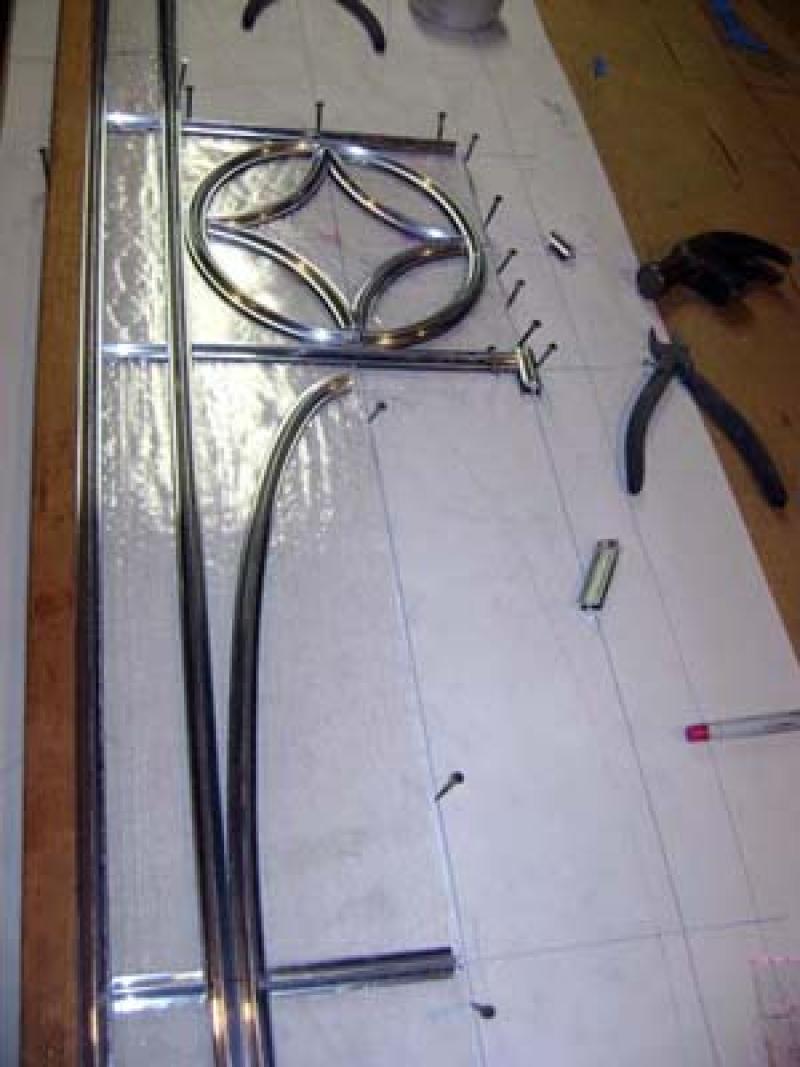
Once a section has been glazed, it's ready to be soldered together. At every joint the lead is soldered together on one side of the section and then turned over to solder the other side's joints as well. Workers wear masks so as to not inhale poisonous lead fumes.
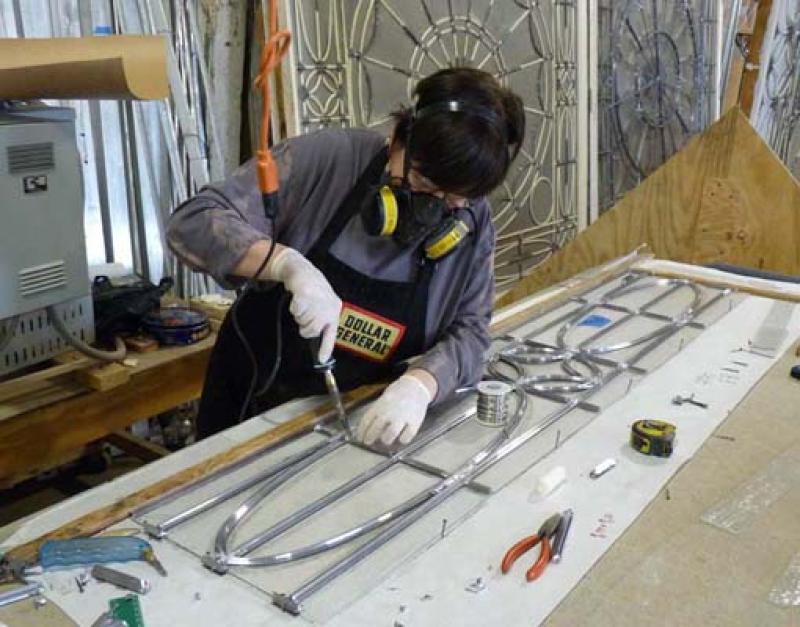
Once a section has been soldered together, the piece goes through the cementing process. The workers use a flexible putty to fill in the spaces between the cames and the glass. The putty works to waterproof the panel while still giving flexibility for the glass to swell and contract in different temperatures without breaking.
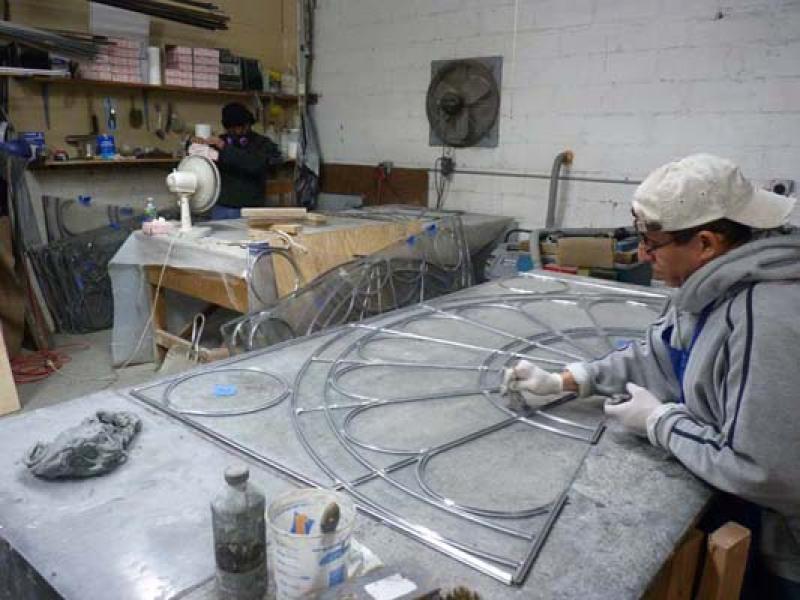
A detail of the putty being rubbed into the crevices between the cames and the glass
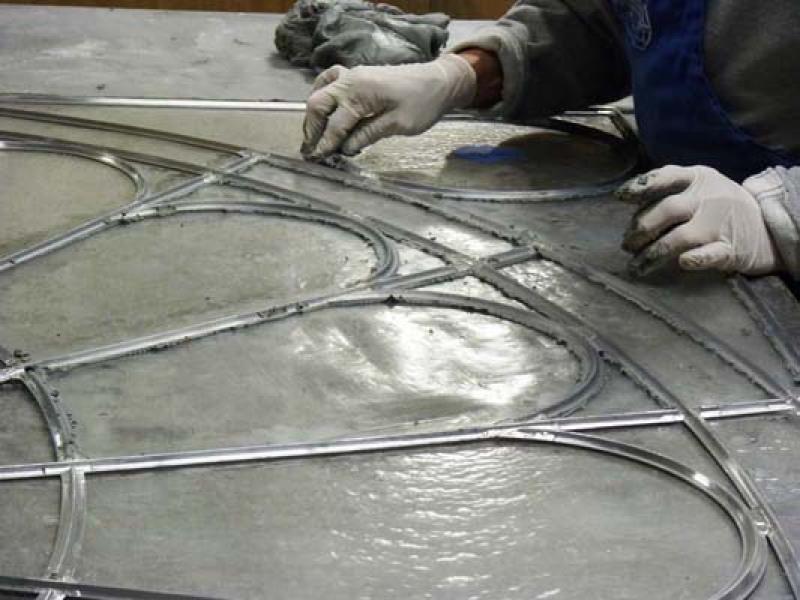
Once each of the eight sections of the panel have been glazed, soldered and cemented, they are ready to be pieced back into the original large, complete panel.
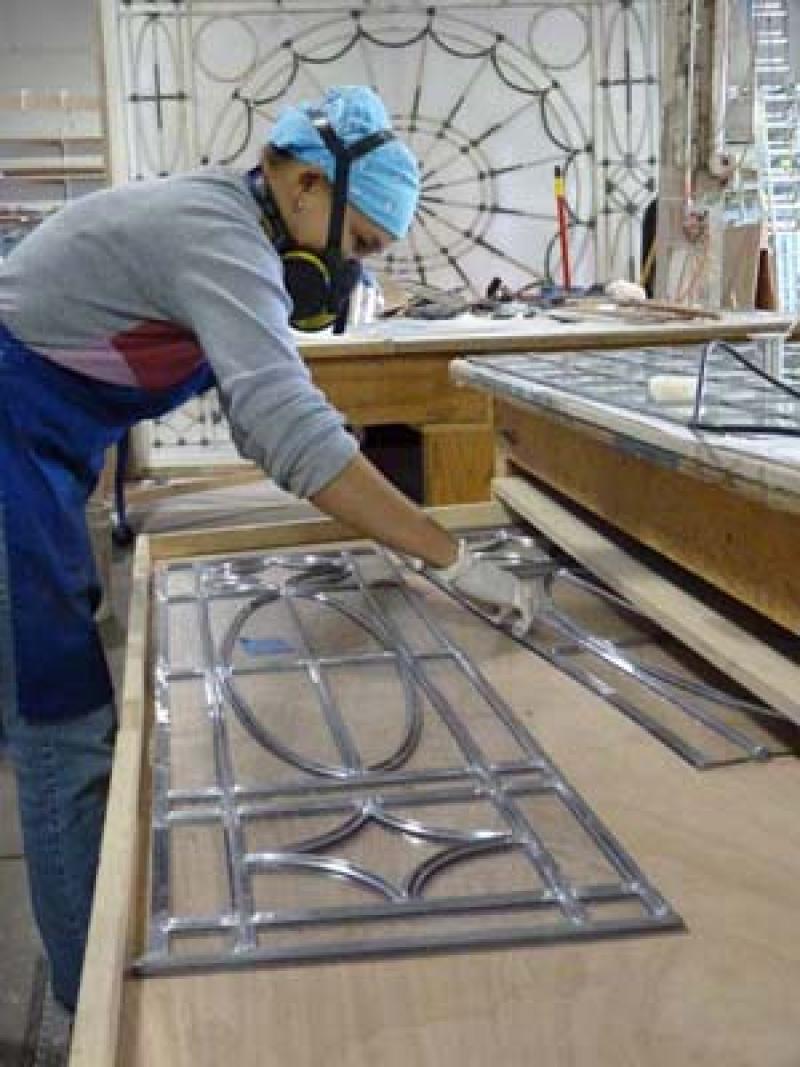
The eight sections are laid flat and pieced together within the wood frame.
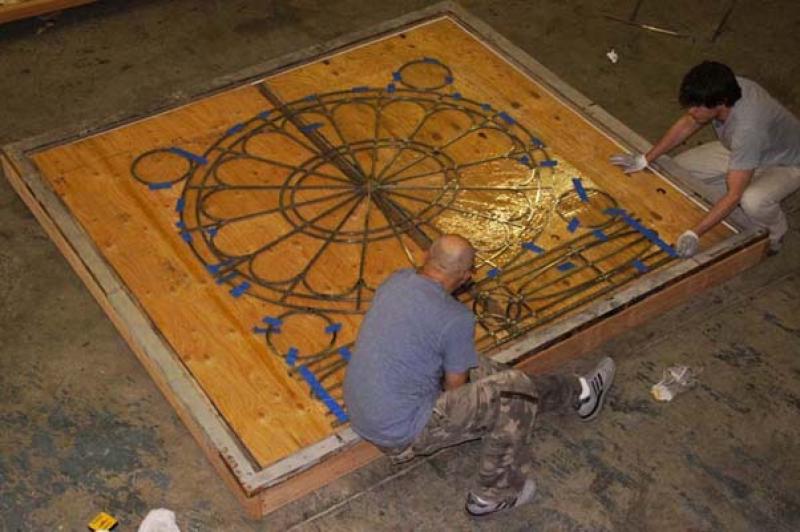
Once the entire panel has been soldered together, then the support system is placed on the back.
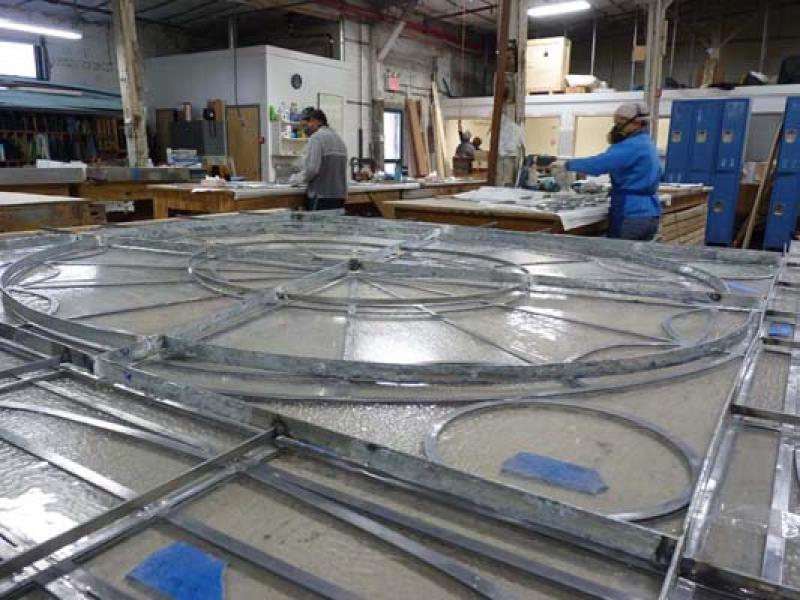
An advanced support system was designed to strengthen the original support system. Following the initial test panel design, Femenella & Associates actually came up with an even stronger support system they are employing on all of the panels. The challenge of designing the support system for the lay light panel was compared to "designing nylons for an elephant" because it is such a large piece and such delicate material.
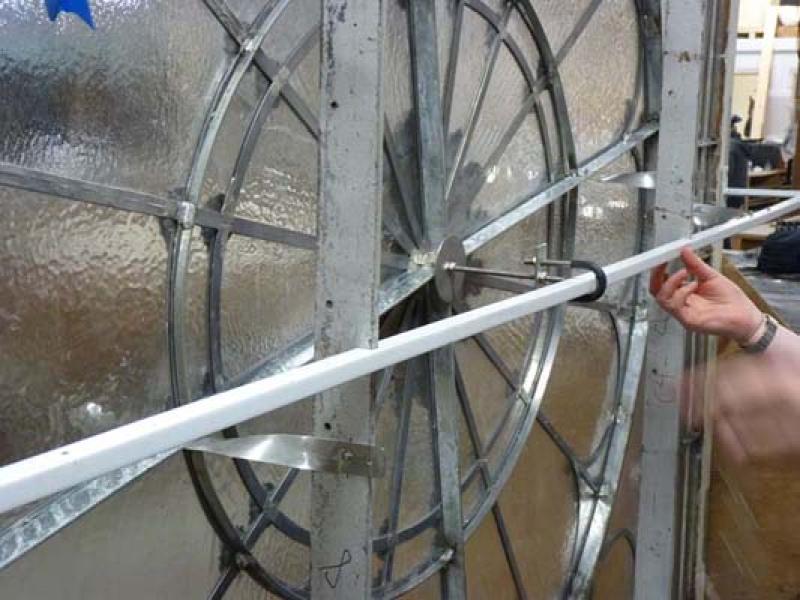
An example of the enhanced support can be seen in this series of photos. The far left shows the center of one of the original panels with only a weak support wire attached to a bar overhead. The center photo shows the first Femenella design used on the initial test panel with additional soldering and half–inch support bars crossing at the center. The photo to the far right, however, is the final support system design that will be used on all panels. Support bars will be 1 inch think and placed along the structural elements of the cames. Additional support measures are deployed to better distribute the support needed at fragile sections like the center of the panel.

The original support bars, the two vertical bars you see in this photo, are also reattached to the panel to help hold the original wood frame tight around the glass.
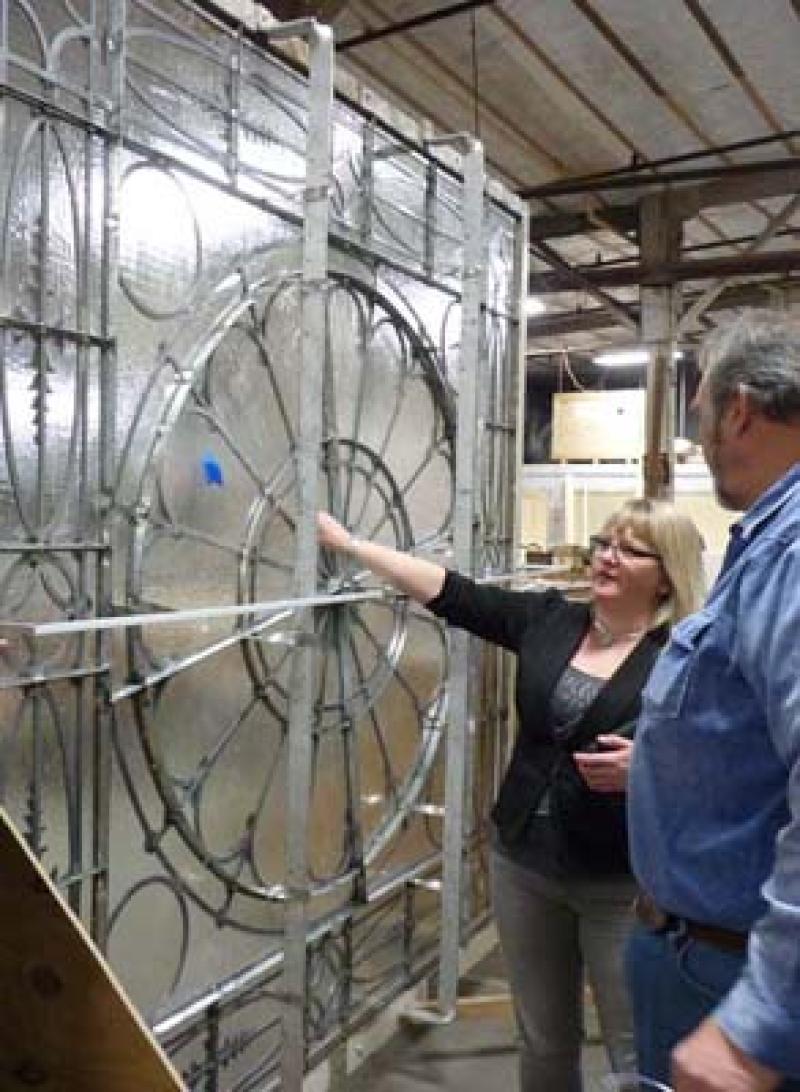
One of the final steps in the process is to solder the decorative ornamentation back onto its original position on the cames. The decision was made to not repaint the cames and ornamentation, as it was believed that the metal was originally left unpainted.
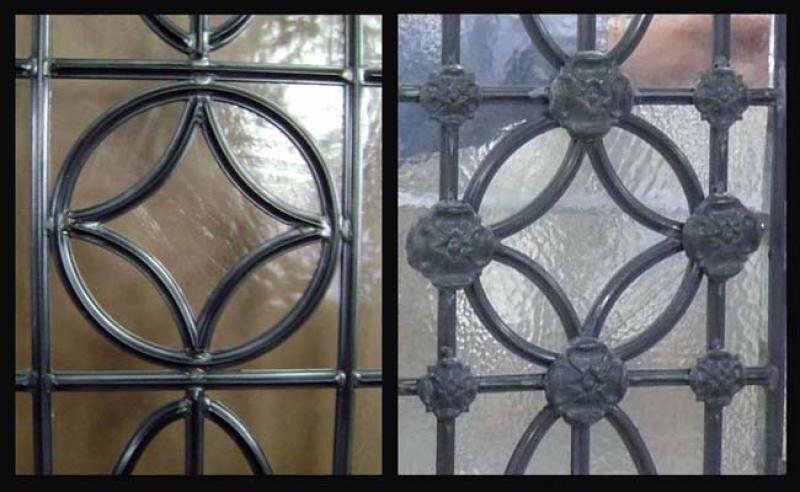
The restored panels are then buffed and prepared to be transported in batches back to Washington, D.C. to be reinstalled in the DAR Library ceiling. In this photo, Art Femenella, whose company is performing the historic restoration of the lay light panels, stands with DAR President General Merry Ann T. Wright, next to a fully complete restored panel.
